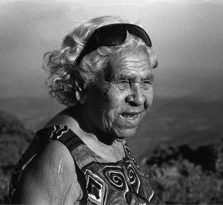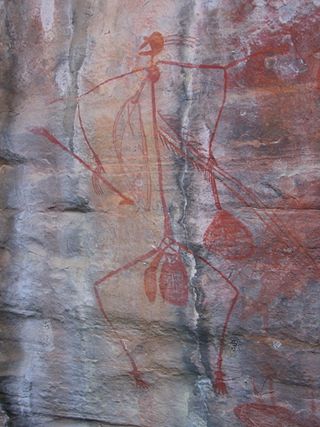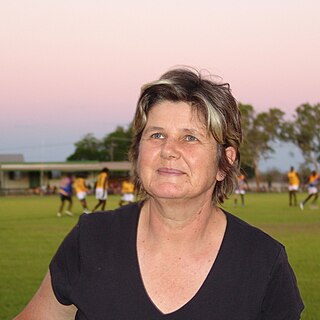Related Research Articles

The Canning Stock Route is a track that runs from Halls Creek in the Kimberley region of Western Australia to Wiluna in the mid-west region. With a total distance of around 1,850 km (1,150 mi) it is the longest historic stock route in the world.

The Wandjina, also written Wanjina and Wondjina and also known as Gulingi, are cloud and rain spirits from Australian Aboriginal mythology that are depicted prominently in rock art in Australia. Some of the artwork in the Kimberley region of Western Australia dates back to approximately 4,000 years ago. Another closely related spirit entity is the creator being Wunngurr, a being analogous to the Rainbow Serpent in other Aboriginal peoples' belief systems, but with a different interpretation.

Kununurra is a town in far northern Western Australia located at the eastern extremity of the Kimberley approximately 45 kilometres (28 mi) from the border with the Northern Territory. Kununurra was initiated to service the Ord River Irrigation Scheme. It is located on the traditional lands of the Miriwoong, an Aboriginal Australian people.

The Noongar are Aboriginal Australian people who live in the south-west corner of Western Australia, from Geraldton on the west coast to Esperance on the south coast. There are 14 different groups in the Noongar cultural bloc: Amangu, Ballardong, Yued, Kaneang, Koreng, Mineng, Njakinjaki, Njunga, Pibelmen, Pindjarup, Wadandi, Whadjuk, Wiilman and Wudjari. The Noongar people refer to their land as Noongar boodja.
The human history of Western Australia commenced between 40,000 and 60,000 years ago with the arrival of Aboriginal Australians on the northwest coast. The first inhabitants expanded across the east and south of the continent.
The Kimberley is the northernmost of the nine regions of Western Australia. It is bordered on the west by the Indian Ocean, on the north by the Timor Sea, on the south by the Great Sandy and Tanami deserts in the region of the Pilbara, and on the east by the Northern Territory.

Queenie McKenzie (Nakarra) (formerly Oakes, or Mingmarriya) (c. 1915 – 16 November 1998) was an Aboriginal Australian artist. She was born on Old Texas Station, on the western bank of the Ord River in the East Kimberley.

The prehistory of Australia is the period between the first human habitation of the Australian continent and the colonisation of Australia in 1788, which marks the start of consistent written documentation of Australia. This period has been variously estimated, with most evidence suggesting that it goes back between 50,000 and 65,000 years. This era is referred as prehistory rather than history because knowledge of this time period does not derive from written documentation. However, some argue that Indigenous oral tradition should be accorded an equal status.
Rover Thomas Joolama, known as Rover Thomas, was a Wangkajunga and Kukatja Aboriginal Australian artist.

Wyndham is the northernmost town in the Kimberley region of Western Australia, 3,315 kilometres (2,060 mi) northeast of Perth via the Great Northern Highway. It was established in 1886 to service a new goldfield at Halls Creek, and it is now a port and service centre for the east Kimberley with a population of 941 as of the 2021 census. Aboriginal and Torres Strait Islander people make up 54% of the population. Wyndham comprises two areas - the original town site at Wyndham Port situated on Cambridge Gulf, and 5 kilometres (3.1 mi) by road to the south, the Three Mile area with the residential and shopping area for the port, also founded in 1886. Wyndham is part of the Shire of Wyndham-East Kimberley.
Australian archaeology is a large sub-field in the discipline of archaeology. Archaeology in Australia takes four main forms: Aboriginal archaeology, historical archaeology, maritime archaeology and the archaeology of the contemporary past. Bridging these sub-disciplines is the important concept of cultural heritage management, which encompasses Aboriginal and Torres Strait Islander sites, historical sites, and maritime sites.

Elizabeth Durack Clancy CMG, OBE was a Western Australian artist and writer.
Devil's Lair is a single-chamber cave with a floor area of around 200 m2 (2,200 sq ft) that formed in a Quaternary dune limestone of the Leeuwin–Naturaliste Ridge, 5 km (3.1 mi) from the modern coastline of Western Australia. The stratigraphic sequence in the cave floor deposit consists of 660 cm (260 in) of sandy sediments, with more than 100 distinct layers, intercalated with flowstone and other indurated deposits. Excavations have been made in several areas of the cave floor. Since 1973, excavations have been concentrated in the middle of the cave, where 10 trenches have been dug. Archaeological evidence for intermittent human occupation extends down about 350 cm (140 in) to layer 30, with hearths, bone, and stone artefacts found throughout. The site provides evidence of human habitation of Southwest Australia 50,000 years before the present day.
The history of the Aboriginal inhabitants of Western Australia has been dated as existing for 50-70 thousand years before European contact. This article only deals with documented history from non indigenous sources since European settlement in Perth.
Lake Jasper is a permanent freshwater lake in the South West area of Western Australia. The lake is the largest freshwater lake in Western Australia. It has evidence of Aboriginal activity within its bounds.
Sandra Bowdler is an Australian archaeologist, emeritus professor of archaeology and former head of the Archaeology Department at the University of Western Australia.

Jane Balme is a Professor of Archaeology at the University of Western Australia. She is an expert on early Indigenous groups and Australian archaeology.
Wendy Beck is an Adjunct Associate Professor at the University of New England in archaeology and cultural heritage.
Duncan Merrilees (1922–2009) was an Australian geologist, palaeontologist, lecturer and curator at the Western Australian Museum. His research on the fossil records of mammals also founded examination into the period after the arrival of humans and their role within the ecology of the Australian continent. His excavations and research into mammalian palaeontology also included description of unknown species of extinct marsupials.
Katheryn Helen Morse was an Australian archaeologist who pioneered research on Pleistocene coastal archaeology in Western Australia.
References
- 1 2 3 4 Dortch, J.; Balme, J.; Bowdler, S.; Randolph, P. (17 March 2016). "Charlie Dortch: History and archaeology across three continents". Australian Archaeology. 79 (1): 78–80. doi:10.1080/03122417.2014.11682021. S2CID 148415039.
- ↑ Dortch, Charles (21 December 2005), "Recent Research in South Western Prehistory", Australian Archaeology, Australian Archaeological Association, ISSN 0312-2417
- ↑ Jensen, Michael; Australian Information Service (1975), Mr Charles Dortch holding rock engravings discovered by Miss Jane Balme and Mrs. Jennifer Porter at the Devil's Lair Cave at Augusta, Western Australia in Perth, 11 June 1975 , retrieved 19 April 2019
- ↑ Dortch, C. E. (Charles E.); Western Australian Museum (1976), Devils lair : a search for ancient man in Western Australia, W.A. Museum Press, ISBN 978-0-7244-6198-1
- ↑ Dortch, C. E. (Charles E.) (1979), Devil's lair : an example of prolonged cave use in south-western Australia, Routledge & Kegan Paul, retrieved 19 April 2019
- ↑ Dortch, C. E. (Charles Eugene) (1971), Report [to A.I.A.S.] on archaeological work carried out in the Ord Reservoir area, east Kimberley, Perth, retrieved 19 April 2019
- ↑ Dortch, C. E. (Charles Eugene), Archaeological work in the Ord Valley, east Kimberley, August-September 1972, Perth, retrieved 19 April 2019
- ↑ Dortch, C. E. (Charles E.); Western Australian Museum. Anthropology Dept; Heritage Council of Western Australia (1997), Survey and assessment of south-west Western Australian submerged prehistoric land surfaces and associated Aboriginal sites. 29 December 1997 final report : archaeological surveys of submerged and shoreline Aboriginal sites in the south-west of Western Australia October 1995 - September 1997 , retrieved 19 April 2019
- ↑ Dortch, C. E. (Charles Eugene) (1997), Prehistory Down Under : archaeological investigations of submerged Aboriginal sites at Lake Jasper, Western Australia , retrieved 20 April 2019
- ↑ Cohn, H. (August 2016). "Dortch, Charlie E. - Biographical entry - Encyclopedia of Australian Science". Encyclopedia of Australian Science. The University of Melbourne eScholarship Research.
- ↑ Dortch, C. E. (Charles Eugene) (2000), Past Aboriginal hunter-gatherer economy and territorial organisation in coastal districts of Western Australia's lower south-west , retrieved 19 April 2019